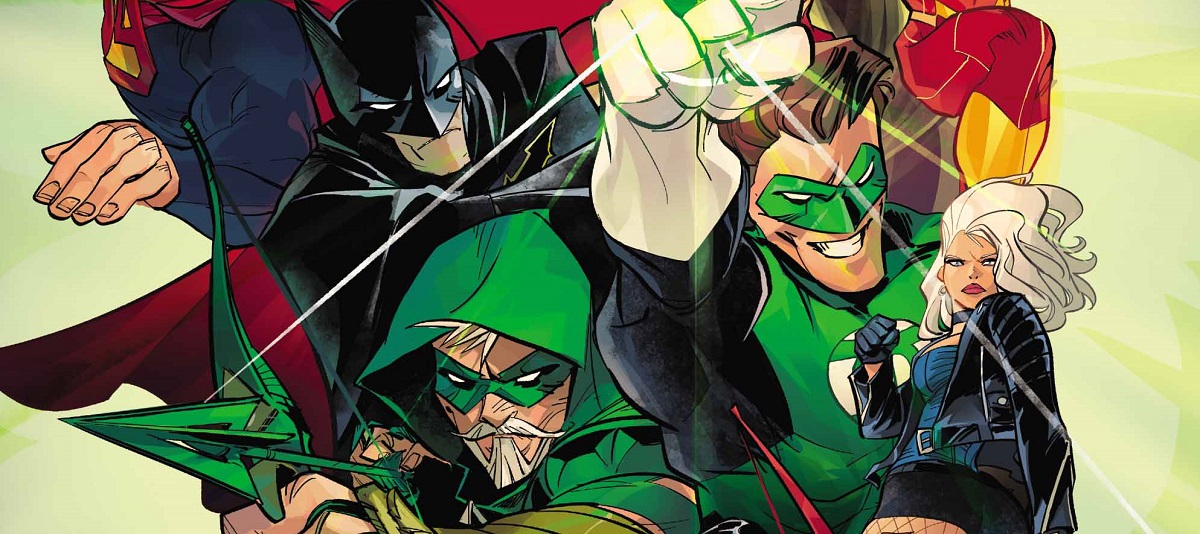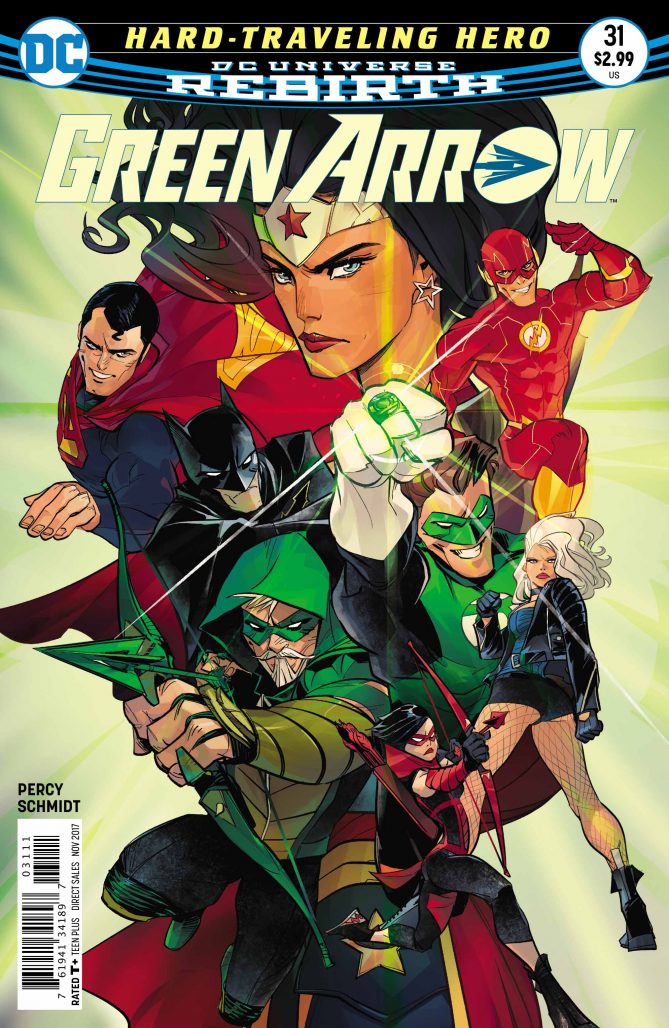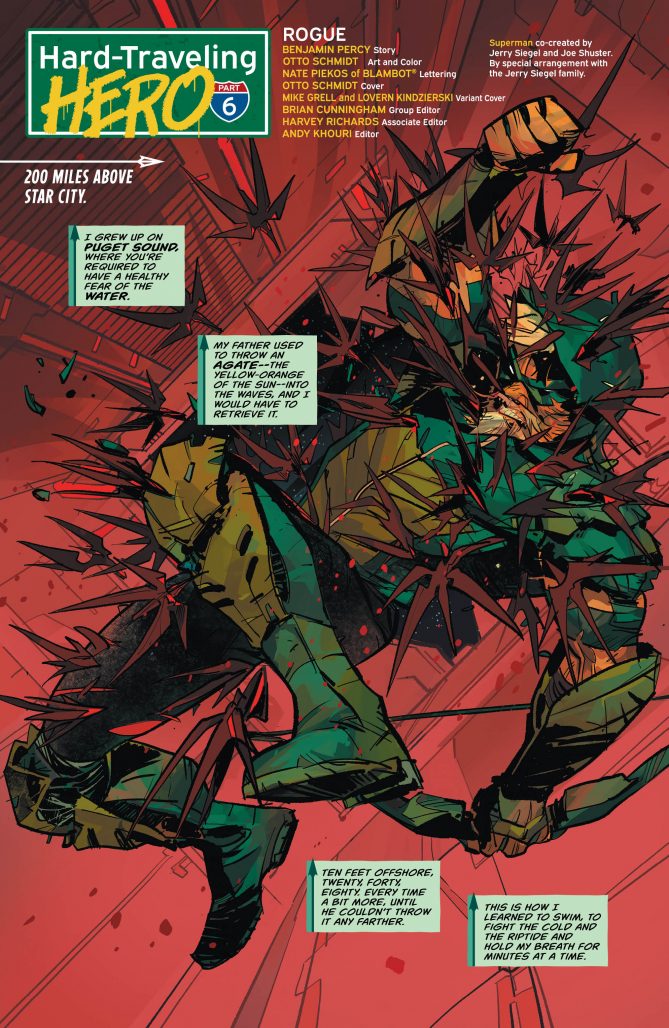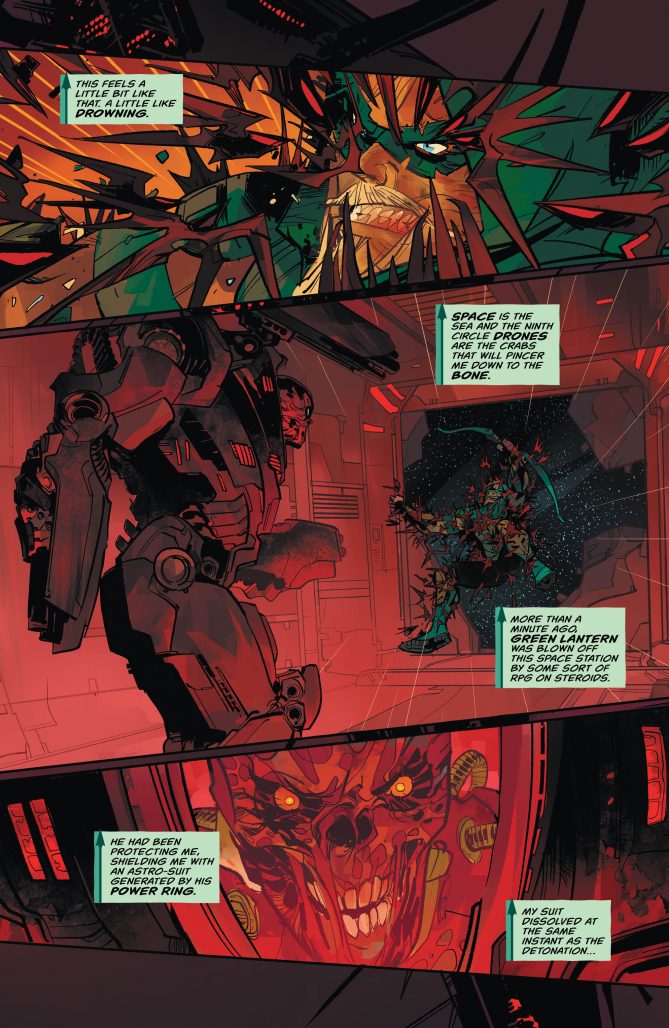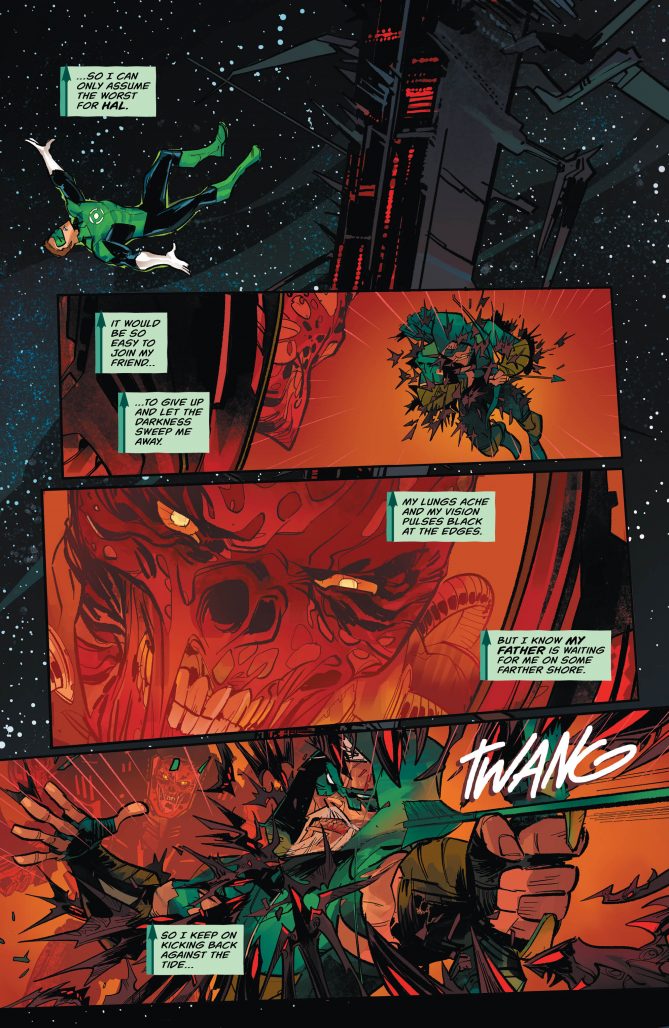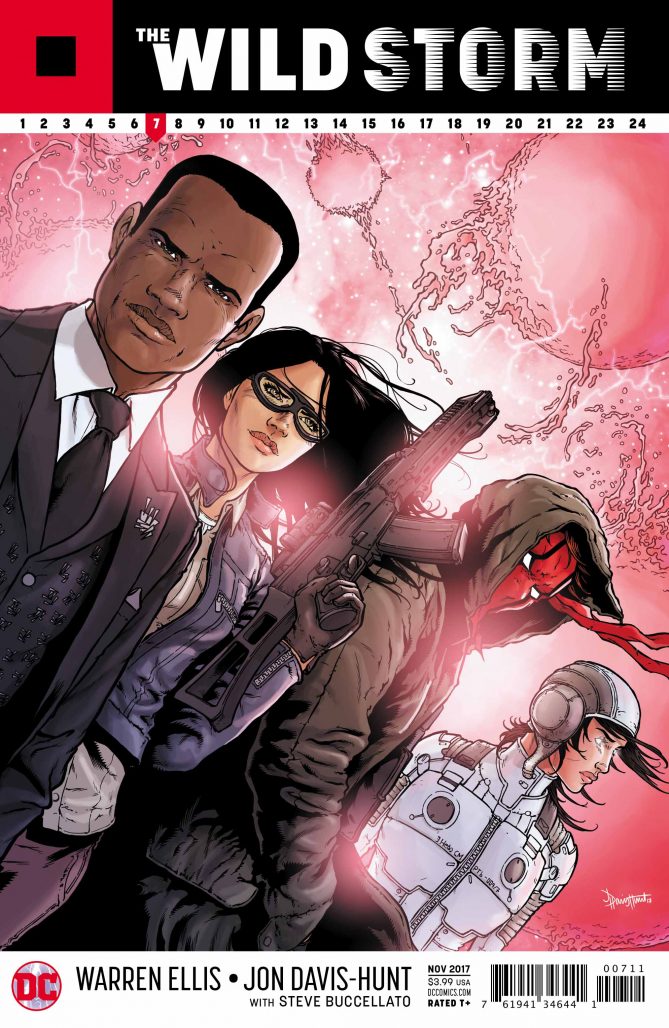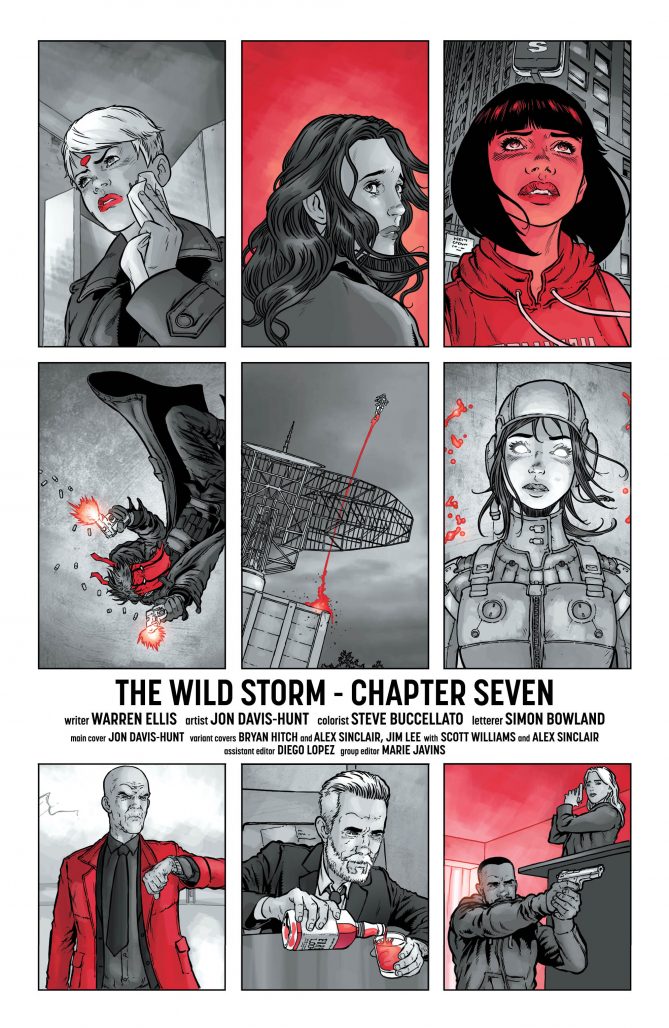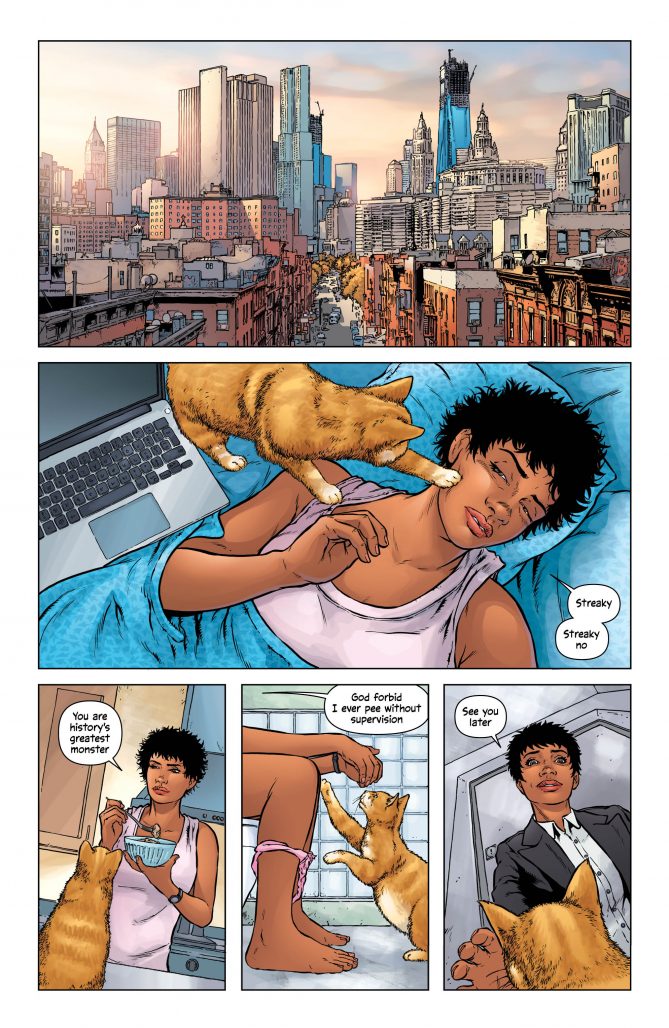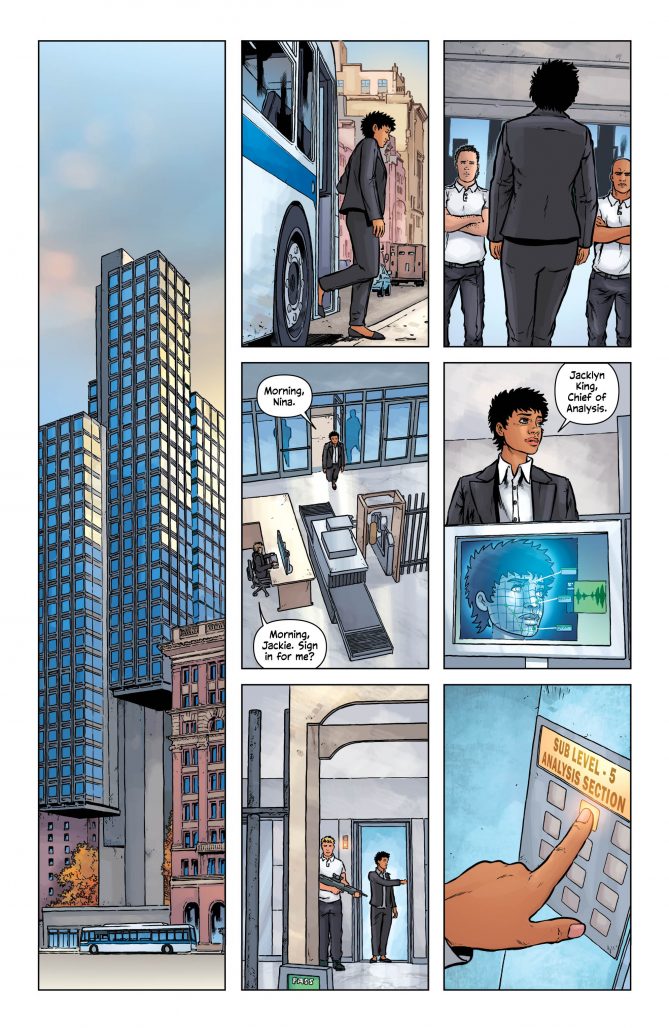In June 2016, DC Comics kicked off the start of its Rebirth initiative. After a wave of criticism surrounding the way they have treated their characters’ rich histories since 2011’s New 52 relaunch, DC has decided to rebrand. They hope that by restoring their characters’ pasts, they will restore readers’ faith in them as well. Do they succeed? That’s what the Comics Beat managing editor Alex Lu and entertainment editor Kyle Pinion are here to discuss. Book by book. Panel by panel.
THIS WEEK: Alex once again takes the wheel as Kyle recovers from SPX and Louie gets settled into his comfy writing chair.
Note: the reviews below contain **spoilers**. If you want a quick, spoiler-free buy/pass recommendation on the comics in question, check out the bottom of the article for our final verdict.
 Green Arrow #31
Green Arrow #31
Writer: Benjamin Percy
Artist: Otto Schmidt
Letterer: Nate Piekos
When DC relaunched their lineup of superhero titles last year, they promised a return to a more classic approach to their characters. Over the course of that year, few titles have managed to adhere to that philosophy and yet simultaneously remain as timely as Green Arrow is. Throughout the past 31 issues, writer Benjamin Percy and lead artists Juan Ferreyra and Otto Schmidt have redefined Oliver Queen as more than just a selfish version of Batman. They’ve knocked Ollie to the ground and forced him to really see the people he’s been “saving,” allowing him to grow into a kinder and more truly populist hero. In doing so, they’ve reestablished Oliver’s place as the preeminent radically progressive superhero.
From the very start, Green Arrow has been a riff on the Robin Hood archetype. He fought the establishment both socially and economically, hoping to take down the powers that be to better his fellow man. Complicating that, however, was Oliver’s own relationship to wealth under the capitalist system. Unlike many of the people he saved, Oliver always had a safety net. He had all the tools and amenities he could ever need. His wealth allowed him to acquire the tools he needed to succeed at his vigilante work, but it also made him a self-admitted asshole of a loner. And being a loner just doesn’t fly when you don’t have a safety net made of solid gold. Real people need friends, and as cliche as it sounds, it’s important that Oliver has truly rediscovered the power of friendship throughout this arc of the series, “Hard-Traveling Hero.”
There’s a very poetic element to the structure of this Green Arrow storyline. For quite some time now, Ollie and his on-and-off partner Black Canary have been fighting the Ninth Circle, an evil underground organization dedicated to acquiring vast amounts of wealth and knowledge that effectively allow them to control the world. They managed to buy Oliver out of his own company before essentially buying Seattle itself, transforming it into the newly branded “Star City.” Without a company or even a literal geographic home city to return to, Oliver has become a vagabond of sorts, following a trail of breadcrumbs across America to find the source of the Ninth Circle’s influence.
Along the way, however, he’s been forced to team up with a variety of heroes including the Flash, Wonder Woman, Superman, Batman, and Green Lantern. And looking back on this arc now, it’s clear that he would never have been able to get to the next stop on his trail without the help of each of these heroes. Without the Flash’s detective skills, Ollie wouldn’t have discovered Lexcorp’s relationship (or lackthereof) to the Ninth Circle. Without Batman’s surveillance, Ollie wouldn’t have learned about the Ninth Circle’s orbital satellite. And without Green Lantern, Ollie would never have been able to make it into space. While Oliver has never had the best relationship with other heroes, losing everything tangible he’s ever owned has put him to put more stock in intangible faith– and that faith has been worth its weight in gold.
So it makes sense that Ollie’s arc should culminate here. With Green Lantern being blasted into the depths of space and taken out of commission, Oliver is forced to finish his mission on his own. His faith in others has taken him a long way, but in order to truly save the world, he’s forced to make the choice to willingly and selflessly take an action that, in all likelihood, results in him sacrificing his life for the greater good. The climactic fight, which culminates in Oliver blowing up the Ninth Circle’s main satellite with himself still on it, is a wonderfully rendered sequence. Schmidt fills page after page with looks at the terrible events that the Ninth Circle’s satellites are capturing around the world, including the torture of Black Canary and Ollie’s half-sister Emi. And in response to every look at the events being broadcast across a countless set of screens, we get a look at the increasingly battered Ollie’s increasingly furious face, filled with resolve.
It’s a beautiful visual sequence that dovetails with the next one, which sees all of Ollie’s superfriends reunite to save him and the world. He gave himself for them and now they’d give themselves for him. Oliver is more than just a hard-traveling hero now. He’s a hard-earned one, too. If you haven’t had a chance to read this Green Arrow run yet, now’s the perfect time to pick up some trades and give it a shot. You’re in for a real treat.
Verdict: Buy
 The Wild Storm #7
The Wild Storm #7
Writer: Warren Ellis
Artist: Jon Davis-Hunt
Colorist: Steve Buccellato
Letterer: Simon Bowland
There’s nothing that I love more than a confident comic. And The Wild Storm #7 has enough confidence to seduce you with just a look from all the way across a crowded room.
How do we define confidence in superhero comics? It comes from a creative team’s complete understanding of the world they’re working with. It comes with knowing how powers like teleportation and transforming into a mech work in the context of their world’s physics. It comes from knowing all of this and having enough restraint to not outright tell the reader how it all works like some sort of fake science textbook, but rather compellingly show us how in teasing glimpses and glances. A confident superhero story trusts its reader enough to indulge utter insanity every issue without holding their hand. The creative team has a vision and all will be revealed as long as the reader has the patience to stick it out– not that The Wild Storm makes sticking it out all that hard at all.
Over the past seven issues, Warren Ellis, Jon Davis-Hunt, Steve Buccellato, and Simon Bowland have been slowly adding pieces to The Wild Storm‘s chessboard. The incredibly dense first issue introduced the initial catalysts for conflict: a researcher who developed a nano-tech suit named Angela Spica, her employer and the man who runs the Earth, International Operations director Miles Craven, and tech genius space alien Jacob Marlowe. Then, the scope of the story quickly expanded to include Henry Bendix, the leader of Skywatch, an organization who controls space and maintains a tenuous and complex peace with IO. And between them all we have spirits of the age, rogue artists, crazy men with penchants for tech and guns, a teleporting former Russian cosmonaut…the list goes on. To say that this book is dense is an understatement.
It’s to the creative team’s incredible credit then, that The Wild Storm feels so fluid and fun. Information comes in drips and drops, with this issue seeing the introduction of a new member of Jacob Marlowe’s special field operation team, John Colt. John’s entrance to the series is casual– one of our earliest leads in the series, Cole Cash aka Grifter, picks up a phone call which takes us deep into one of IO’s bases where John has been embedded as a spy. The entrance is so natural and so little attention is called to it that John feels like he’s been in the fabric of this story all along. He’s not a new element, but an old friend. And of course, the first thing we get to see this new/old friend do is murder a whole bunch of red shirts after his cover is blown.
The Wild Storm would not be half the book that it is without Jon Davis-Hunt and Steve Buccellato. Jon has an incredible eye for pacing action. As our principle character in this scene, John, runs down a hall into the first group of guards, we see the focus zoom in on the guards’ suspicious faces. We pull in further to one of the guards reaching for his gun holster, then pull back to a close up of John’s face. This series of shots establish the tension of the moment. We all know what’s about to happen. On the next page, we cut back and forth between John and the guards as John rushes towards them, closing the distance with every frame. John fires. A guard falls. Then, we get a whole page dedicated to the acrobatics of a single move John uses to take down the next guard. Davis-Hunt pushes and pulls at the speed of time throughout this fight in a way that only comics can.
I’ve never read any of the old WildStorm material. I can’t comment on how faithful this series is to the old universe or on how these two compare on relative planes of quality. What I can say though is that The Wild Storm is easily one of my favorite, if not my number one favorite, DC Comic on the shelf right now.
Verdict: Buy
Round-Up
- The Metal “Evil Batman” oneshots begin this week with the release of Batman: The Red Death #1. As far as debuts go, this isn’t the best event spinoff I’ve ever seen. I’m not a huge fan of the way this story feels the need to exposit so many minor elements and have every character explain their motivations in full– it’s a bit anachronistic of a writing style; much more reminiscent of a golden age comic than a modern one. That said, I do like how utterly insane some of the ideas explored in this story are. That element reminds me a lot of the “Darkseid War” specials that showcased members of the Justice League gaining the power of various New Gods. They were utter nonsense, but lord almighty they knew it and they went with it, as does Batman: The Red Death. Oh, and I’m always on board for the neon hues that Ivan Pascencia colors Carmine Di Giandomenico’s Flash and Flash-adjacent work with.
- It’s hard to believe, but we’re finally nearing the end of “The War of Jokes and Riddles” in Batman #31. This has been something of an inconsistent arc for the series, but taken as a whole I think it works relatively nicely. The highlight, of course, is getting to watch Mikel Janin work his magic on Gotham with June Chung on colors. There’s something incredibly refreshing about seeing a whole chapter of Batman take place in broad daylight. The bright colors allow us to get great looks at the madness in the Joker’s eyes and the detailing on Catwoman’s early costume.


